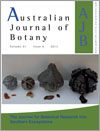Australian Journal of Botany
Volume 61
Number 6 2013
The leaves of cat’s claw creeper (Doichandra unguis-cati) vary in their morphology between and within individual plants. The purpose of this study is to document some of this variation in part of the plant’s invasive range in south-east Queensland. Proportions of simple and compound leaves differ between the two forms present in the region, and between shoots that are climbing trees or covering the ground. This variation is discussed in relation to genetic variation, development and biocontrol.
In this study we examined differences in LMA and leaf pigments and determined the scaling relationship between them for 63 woody species (belonging to two life forms) that were collected from two altitudes of Gongga Mountain in Southwest China. Leaf pigment concentrations were not significantly influenced by altitude but, with increasing altitude, the chlorophyll (Chl) a : Chl b ratio increased in evergreen species and LMA increased in deciduous species. Allometric analyses showed that the increase in LMA with increasing mass-based pigment concentrations was greater in evergreens than in deciduous species and at high compared with low altitude. We suggest that evergreen and deciduous species may use different photoprotection and utilization strategies to cope with environmental stresses.
Identifying the timing of diversification of lineages provides a framework for understanding their biogeographical history. Past attempts to date the evolutionary history of Acacia have used small datasets with few fossil calibrations, leading to conflicting results. This study uses multiple datasets and improved fossil calibrations to date the major diversifications, which are coincident with Miocene aridfication.
BcSKS11 is a SKS gene that is specifically expressed in uninucleate microspores, mature pollen grains and growing pollen tubes of pollinated pistils of Chinese cabbage pak choi. A phylogenetic tree constructed from 49 SKS proteins shows that BcSKS11 is in a clade with tobacco sequences and arabidopsis SKS11-SKS14. Results suggest that BcSKS11 might be stored in mature pollen grains, in preparation for pollen germination and pollen-tube growth.
The introduction of non-indigenous species into modified landscapes risks negative consequences for the genetic purity of indigenous species if they are capable of hybridising. Using molecular markers and a hybrid index on open-pollinated offspring of tuart (Eucalyptus gomphocephala) in urban bushland remnants in Perth, Western Australia, we found no evidence for hybridisation. Our results highlight that the ongoing invasion of introduced species, and in particular E. cladocalyx (sugar gum), is currently a greater risk than hybridisation for tuart conservation in these remnants.
Differences in response to fire between Tasmanian and Australian mainland alpine vegetation are hypothesised to be due to the overarching impact of climate, with the amount of snow cover influencing fire-controlling mechanisms such as marsupial herbivore grazing, the exposure of soil and vegetation to extreme microclimatic conditions and the degree of shrub dominance.
Bromus pictus and Poa ligularis are native forage Patagonian grasses threatened by sheep. We examined genecological trait variation along latitude using isozyme electrophoresis and common garden. We detected elevated within-population genetic diversity, a significant genetic structure, and evidence of local adaptation to be used in conservation and restoration actions.
Protecting seeds in woody containers is a common feature in southern hemisphere woody plants, but the cones of southern conifers have been little studied. Cones occur in Callitris in Australia and New Caledonia and Widdringtonia in South Africa and vary greatly in size, whether they stay closed for some years on the plant (serotiny) and how well they protect the seeds from the heat of a fire. Examining the environmental features that are associated with whether cones stay closed or not helps understand the reproductive and ecological behaviour of the trees.




